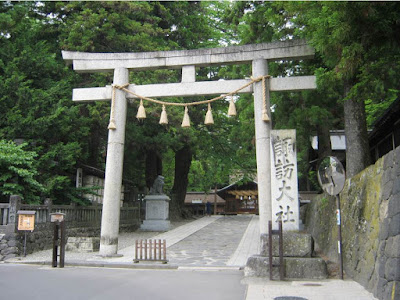On-bashira means a great wooden pole.
Every six years, big Japanese fir trees which are more than 150 years old are
selected in the designated forests and brought to the Suwa great shrine. The
event is called “On-bashira festival”.
 |
| The gate of the Suwa Spring great shrine, Jun in 2017(諏訪大社下社春宮) |
 |
| On-bashira and the main hall of the Suwa Spring great shrine(下社春宮) |
The trees are stood in the shrine. The
Suwa people have been into this event more than 1000 years. The day of “On-bashira
festival” is a local holiday.
御柱の切り出しから、街中を練り歩く。豪快な山出しだけでなく、子供たちの練り歩きや女性の行列も含めて、御柱を立て終わるまでの大変な行事だ。数えで7年に一度(6年ごと)というが、2万町民が支える大行事だ。この町に生まれたら楽しまざるを得ないという感じ。
The event starts by selecting the
proper tree, and then cutting down the tree. Eight trees are cut. Four trees are for
the Spring shrine, and other four trees are for the Autumn shrine. The Suwa god
stays in the Spring shrine from the season of seeding to the season of
harvesting. Following the harvesting, the Suwa god moves to the Autumn shrine by
the big wooden ship which Suwa people carry.
 |
| The main hall of the Autumn shrine(下社秋宮本殿) |
 |
| The kagura dancing hall of the Autumn shrine(下社秋宮神楽殿) |
Anyway, people draw out the trees one by one
from the mountain. There are several points of “Kiotoshi” on the way to the
Suwa town. Many people gather from all over Japan to see it. The trees have to wait for one month for the next event. In mid-May, the trees are brought to the shrines
and stood up.
The population of Simo-Suwa town is only
20,000, so it is not a big town. I respect that Suwa people have continued this
big event more than thousand years. It is worth for Suwa people to work for the
Suwa great shrine, to gather sightseers and host them. They spend a lot of time for it such as practicing singing, dancing and playing. Children learn the festival song in the elementary school. The fun thing in this town is very clear. It seems that everyone who lives here is forced to enjoy On-bashira festival.
I must add that trees are also brought from mountains for ordinary shrines in this area. In this museum, you can get on the tree which vibrates you like sliding On-bashira.
・木遣りの練習(学校でも取り上げられているとのこと)、踊り、演奏の練習、これらを経て本番となる。また、狭い場所での木の引き回しで見物人をうならせるのは、京都の祇園祭にも通じていると思う。I must add that trees are also brought from mountains for ordinary shrines in this area. In this museum, you can get on the tree which vibrates you like sliding On-bashira.
・木を選んでの切り出し、山からの引き出し(山出し、有名な木落しの場所は何か所かにある)、一月ほど置いてからの里曳き。春宮、秋宮用に合計8本を切り出す。神様は、種まきから刈り入れまでの間は春宮にいる。宮間の移動は船を使った。神様の移動も大変なパレードだ。人口2万の町でよくできるものだと思う。
・諏訪大社にお仕えすること、見物人を集めることが、この街の人々の一の楽しみだと感じた。はっきりした街だ。他にも、中山道と甲州街道の交点、温泉とアトラクションが多い街だ。
・諏訪大社用ではない神社用の木の切り出しもイベントとなっている。
 |
| The gate of Upper Suwa great shrine, March in 2017(諏訪大社上社本宮) |
 |
| The road to the main hall covered with snow, March in 2017 So sacred morning ! |
http://www.town.shimosuwa.lg.jp/www/contents/1475302926742/index.html , accessed in May, 2018
Previous post (Museum at the old post town)
: Shimo-Suwa
History and Folklore Museum 下諏訪町立歴史民俗資料館
Next
post (Museum of the post town in the same prefecture) : Unno
post town museum of history and folklore 海野宿歴史民俗資料館

Comments
Post a Comment